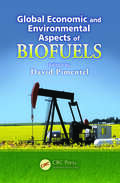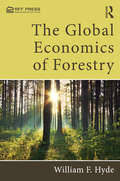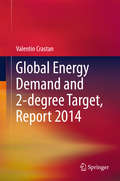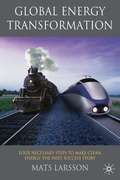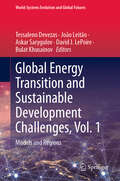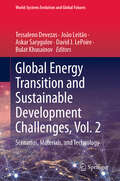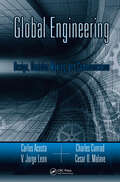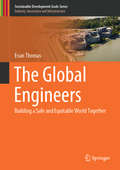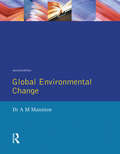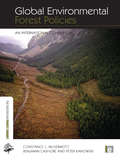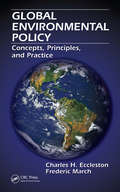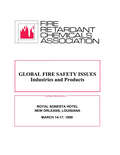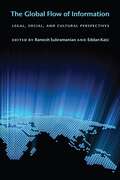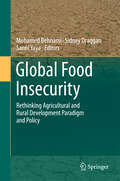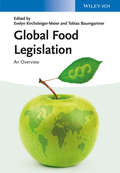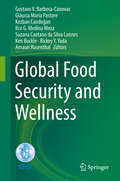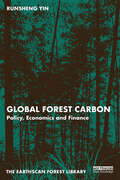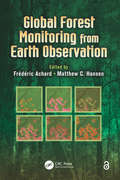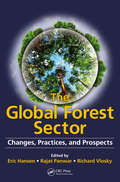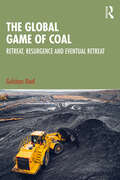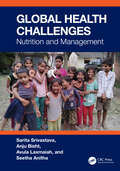- Table View
- List View
Global Economic and Environmental Aspects of Biofuels
by David PimentelBiofuels and food are dependent on the same resources for production: land, water, and energy. The conjuncture of food, energy, and climate crises demands a new direction in how to harness agriculture to the joint tasks of energy-saving, emissions reduction, and food security. Global Economic and Environmental Aspects of Biofuels focuses on the all
The Global Economics of Forestry
by William F. HydeThis book traces the economic and biological pattern of forest development from initial settlement and harvest activity at the natural forest frontier to modern industrial forest plantations. It builds from diagrams describing three discrete stages of forest development, and then discusses the management and policy implications associated with each, supporting its observations with examples and data from six continents and from both developed and developing countries. It shows that characteristic distinctions between the three stages make forestry unusual in natural resource management and that effective policy requires different, even contrasting, decisions at each stage. William F. Hyde’s comprehensive discussion covers a wide range of issues, including the impacts of both specific forest policies and broader macroeconomic policies, the unique requirements of current issues such as global warming, biodiversity and tourism, and the complexities of the different forest products industries. Concluding chapters review the roles of the newer institutional landowners, of smaller private and farm landowners, and of public agencies. This highly-original volume reaches far beyond forest economics; it explains what forestry can do for regional development and environmental conservation and what policies designed for other sectors and the macro-economy can do for forestry.
Global Energy Assessment
by Nebojsa NakicenovicThe Global Energy Assessment (GEA) brings together over 300 international researchers to provide an independent, scientifically based, integrated, and policy-relevant analysis of current and emerging energy issues and options. It has been peer-reviewed anonymously by an additional 200 international experts. The GEA assesses the major global challenges for sustainable development and their linkages to energy; the technologies and resources available for providing energy services; future energy systems that address the major challenges; and the policies and other measures that are needed to realize transformational change toward sustainable energy futures. The GEA goes beyond existing studies on energy issues by presenting a comprehensive and integrated analysis of energy challenges, opportunities and strategies, for developing, industrialized and emerging economies. This volume is an invaluable resource for energy specialists and technologists in all sectors (academia, industry, and government) as well as policymakers, development economists and practitioners in international organizations and national governments.
Global Energy Demand and 2-degree Target, Report 2014
by Valentin CrastanThis report takes a neutral and independent point of view in attempting to show concrete ways to achieve the goal of reducing CO2 emissions and limiting global warming to the 2-degree target. It presents an overall picture spanning all key countries. In the report, the temporal evolution of the main parameters is given from 1970 to 2011 for all regions of the world and all G-20 countries, starting from the basic data, gross domestic consumption. The parameters are then extrapolated to 2030, taking into account current trends, local factors and the requirements of the 2-degree climate target. An important basis is the structure of the current energy consumption and energy flows of all regions of the world and all G-20 countries, which is analyzed in the appendix in detail and reproduced as clearly as possible. The reports from climate science make it clear that with a greater level of warming, adaptation is the more expensive option. Compliance with the 2-degree climate target is a challenge, but not impossible. The book is intended not only for the scientific community but also for decision makers in government and industry.
Global Energy Transformation
by Mats LarssonPhilip Delves Broughton. bestselling business author of What They Teach You at Harvard Business School, takes a sideways look at the greatest salespeople in Life's a Pitch. What do the best rug seller in Tangier, the king of the US cable channels and the guru of the Japanese life insurance industry have in common? What makes the difference between an ordinary salesperson and the top 'gunslingers'?Philip Delves Broughton - author of the bestselling What They Teach You At Harvard Business School - has journeyed around the world to meet living legends of sales from all walks of life. Their stories are at once insightful, human and humorous. Delves Broughton reveals the ingredients needed to make a perfect sale, and show us how commercial genius might live in all of us. At every step of this journey we learn that selling - be it a product, person or even an idea - is something we all do every day. We are always pitching and presenting, trying to persuade people to accept us. Master the art of the sale and you will master the art of life. 'A marvellous book about selling, and life, and who we are and how we tick. . . dazzling' - Tom Peters, author of In Search of Excellence'You can never look upon a sale in quite the same way again. Buy Life's a Pitch and be enlightened' - Adrian Wooldridge, The EconomistPhilip Delves Broughton is the author of the international bestseller What They Teach You at Harvard Business School. He was born in Bangladesh and grew up in England. He served as the New York and Paris bureau chief for the Daily Telegraph, and he now writes for publications including the Financial Times, the Evening Standard, and the Wall Street Journal. In 2006 he received an M. B. A. from Harvard Business School. He lives in Connecticut with his wife and two sons.
Global Energy Transition and Sustainable Development Challenges, Vol. 1: Models and Regions (World-Systems Evolution and Global Futures)
by Tessaleno Devezas João Leitão Askar Sarygulov David J. LePoire Bulat KhusainovThis two-volume book presents the challenges of the global energy transition, offering a comprehensive exploration of the policies and drivers shaping the pace and trajectory of this transformation. Highlighting regional development, the book shows how different models and scenarios of energy transition emerge. It discusses important factors, such as materials and technologies, shedding light on the opportunities and constraints for the energy transition. Global warming and climate change influenced the change in people’s consciousness and their awareness of the need for more limited use of hydrocarbon resources. Changes in weather conditions, rising sea levels, and destructive climate events such as hurricanes, forest fires, droughts, floods, etc. have become more frequent. Many countries around the world, reacting to these changes, have developed long-term plans to actively replace fossil fuels - gas, oil, and coal with renewable energy sources, mainly solar and wind. However, the low replacement rates observed in the global energy sector over the past 30 years raise the question of how far the decarbonization scenarios and models being implemented by many countries bring us closer to the ultimate goal of creating an economy with a low carbon footprint. Seeking answers, the volumes feature 22 chapters split across the two books, which in detail discuss various aspects of the energy transition and their impact on the sustainability of economic development and the future of energy. This first volume, "Models and Regions," focuses on regional disparities and economic drivers, presenting case studies from different regions in 10 chapters.
Global Energy Transition and Sustainable Development Challenges, Vol. 2: Scenarios, Materials, and Technology (World-Systems Evolution and Global Futures)
by Tessaleno Devezas João Leitão Askar Sarygulov David J. LePoire Bulat KhusainovThis two-volume book presents the challenges of the global energy transition, offering a comprehensive exploration of the policies and drivers shaping the pace and trajectory of this transformation. Highlighting regional development, the book shows how different models and scenarios of energy transition emerge. It discusses important factors, such as materials and technologies, shedding light on the opportunities and constraints for the energy transition. Global warming and climate change influenced the change in people’s consciousness and their awareness of the need for more limited use of hydrocarbon resources. Changes in weather conditions, rising sea levels, and destructive climate events such as hurricanes, forest fires, droughts, floods, etc. have become more frequent. Many countries around the world, reacting to these changes, have developed long-term plans to actively replace fossil fuels - gas, oil, and coal with renewable energy sources, mainly solar and wind. However, the low replacement rates observed in the global energy sector over the past 30 years raise the question of how far the decarbonization scenarios and models being implemented by many countries bring us closer to the ultimate goal of creating an economy with a low carbon footprint. Seeking answers, the volumes feature 22 chapters split across the two books, which in detail discuss various aspects of the energy transition and their impact on the sustainability of economic development and the future of energy. This second volume, "Scenarios, Materials, and Technology," explores mechanisms and technological drivers for a sustainable transition in 12 chapters, from local industries to national economies.
Global Engineering: Design, Decision Making, and Communication (Systems Innovation Book Series)
by Carlos Acosta V. Jorge Leon Charles R. Conrad Cesar O. MalaveAs the world becomes increasingly globalized, today's companies expect to hire engineers who are effective in a global business environment. Although you can find many books covering globalization, most of them are aimed at business, management, or social sciences. Developed with engineers in mind, Global Engineering: Design, Decision Making, and C
The Global Engineers: Building a Safe and Equitable World Together (Sustainable Development Goals Series)
by Evan ThomasThe Global Engineers: Building a Safe and Equitable World Together, is inspired by the opportunities for engineers to contribute to global prosperity. This book presents a vision for Global Engineering, and identifies that engineers should be concerned with the unequal and unjust distribution of access to basic services, such as water, sanitation, energy, food, transportation, and shelter. As engineers, we should place an emphasis on identifying the drivers, determinants, and solutions to increasing equitable access to reliable services. Global Engineering envisions a world where everyone has safe water, sanitation, energy, food, shelter, and infrastructure, and can live in health, dignity, and prosperity.This book seeks to examine the role and ultimately the impact of engineers in global development. Engineers are solutions-oriented people. We enjoy the opportunity to identify a product or need, and design appropriate technical solutions. However, the structural and historical barriers to global prosperity requires that Engineers focus more broadly on improving the tools and practice of poverty reduction and that we include health, economics, policy, and governance as relevant expertise with which we are conversant.Engineers must become activists and advocates, rejecting ahistorical technocratic approaches that suggest poverty can be solved without justice or equity. Engineers must leverage our professional skills and capacity to generate evidence and positive impact toward rectifying inequalities and improving lives.Half of this book is dedicated to profiles of engineers and other technical professionals who have dedicated their careers to searching for solutions to global development challenges. These stories introduce the reader to the diverse opportunities and challenges in Global Engineering.
Global Environmental Change: A Natural and Cultural Environmental History
by Antoinette MannionNow in its second edition. This text has been extensively revised and rewritten to reflect the growth in environmental research during the last decade. Human-induced environmental change is occurring at such a rapid rate that, inevitably, the fundamental processes involved in biogeochemical cycling are being altered. Global Environmental Change considers alterations to the biogeochemical cycles of carbon, nitrogen, sulphur and other elements as a result of industrial/technological development and agriculture, which have significantly altered the natural environment. The book adopts a temporal and spatial approach to environmental change, beginning with the natural environmental change of the Quaternery period and continuing with the culturally-induced change since the inception of agriculture 10,000 years ago.
The Global Environmental Effects During and Beyond COVID-19: Intelligent Computing Solutions (Studies in Systems, Decision and Control #369)
by Aboul Ella Hassanien Ashraf Darwish Benji Gyampoh Alaa Tharwat Abdel-Monaim Ahmed M. AnterThis book aims through 11 chapters discussing the problems and challenges and some future research points from the recent technologies point of view such as artificial intelligence and the Internet of things (IoT) that can help the environment and healthcare sectors reducing COVID-19.
Global Environmental Forest Policies: An International Comparison (The Earthscan Forest Library)
by Constance McDermott Benjamin Cashore Peter KanowskiMarket globalization and the globalization of environmental concerns have spurred demand for greater international accountability for forest stewardship. In response, a range of multi-lateral governmental and non-governmental initiatives have emerged to redefine the rules of global trade, and demand verification of the legality and/or sustainability of forest products originating from within and outside national boundaries. At the same time there is a lack of transparency and shared understanding about the environmental forest policies that already exist within the world's leading forest producing and consuming countries. The result is that many stakeholders have developed perceptions about a country's regulatory environment that are not consistent with what is actually taking place. This book provides a uniquely detailed and systematic comparison of environmental forest policies and enforcement in twenty countries worldwide, covering developed, transition and developing economies. The goal is to enhance global policy learning and promote well-informed and precisely tuned policy solutions.
Global Environmental Policy: Concepts, Principles, and Practice
by Charles H. Eccleston Frederic MarchEnvironmental policy is often practiced reactively with each crisis addressed as an isolated event. Focusing on development of proactive policies, Global Environment Policy: Concepts, Principles, and Practice provides the essential scientific and socioeconomic framework for formulating pragmatic and comprehensive environmental policies. It discusse
Global Fire Safety Issues: Industries and Products
by FrcaThis book is a compilation of papers presented at the 1999 Spring International Conference held in New Orleans, Louisiana. The papers provide a detailed account of various flame retardants along with the developments in the field, primarily focusing on engineering plastics applications.
The Global Flow of Information: Legal, Social, and Cultural Perspectives (Ex Machina: Law, Technology, and Society #5)
by Ramesh Subramanian Eddan KartzThe Internet has been integral to the globalization of a range of goods and production, from intellectual property and scientific research to political discourse and cultural symbols. Yet the ease with which it allows information to flow at a global level presents enormous regulatory challenges. Understanding if, when, and how the law should regulate online, international flows of information requires a firm grasp of past, present, and future patterns of information flow, and their political, economic, social, and cultural consequences.In The Global Flow of Information, specialists from law, economics, public policy, international studies, and other disciplines probe the issues that lie at the intersection of globalization, law, and technology, and pay particular attention to the wider contextual question of Internet regulation in a globalized world. While individual essays examine everything from the pharmaceutical industry to television to “information warfare” against suspected enemies of the state, all contributors address the fundamental question of whether or not the flow of information across national borders can be controlled, and what role the law should play in regulating global information flows.Contributors: Frederick M. Abbott, C. Edwin Baker, Jack M. Balkin, Dan L. Burk, Miguel Angel Centeno, Dorothy E. Denning, James Der Derian, Daniel W. Drezner, Jeremy M. Kaplan, Eddan Katz, Stanley N. Katz, Lawrence Liang, Eli Noam, John G. Palfrey, Jr., Victoria Reyes, and Ramesh Subramanian
Global Food Insecurity
by Sanni Yaya Mohamed Behnassi Sidney DragganHuman-kind and ecological systems are currently facing one of the toughest challenges: how to feed more billions of people in the future within the perspective of climate change, energy shortages, economic crises and growing competition for the use of renewable and non renewable resources. This challenge is even more crucial given that we have not yet come close to achieving the Millennium Development Goal of halving the number of people living in extreme poverty and hunger. Scientists and relevant stakeholders are now voicing a clear message: that multiple challenges the world is facing require innovative, multifaceted, science-based, technological, economic and political approaches in theoretical thinking, decision making and action. With this background central to survival and well-being, the purpose of this volume is to formulate and promote relevant theoretical analysis and policy recommendations. The major perspective of this publication is that paradigm and policy shifts at all levels are needed urgently. This is based on the evidence that agriculture in the 21st century will be undergoing significant demands, arising largely from the need to increase the global food enterprise, while adjusting and contributing to climate change adaptation and mitigation. Global Food Insecurity aims at providing structure to effect achievement of this critically needed roadmap.
Global Food Legislation
by Evelyn Kirchsteiger-Meier Tobias BaumgartnerFilling a distinct need in the globalized food economy, this introductory reference distils the key facts and regulations from the food laws of ten major countries across four continents. The result is a truly global survey of the world's most important food markets in terms of regulatory standards, principles and the authorities involved. The tried-and-tested concept behind the book originates from a regular summer school on food law for non-lawyers organized by the editors, and dispenses with formalized legal language such that the content may be used by food specialists without a law degree. By virtue of its systematic structure, the book allows different market conditions to be easily compared, and global trends in food legislation can be followed. Key facts for food producers active on the international market, who often lack the time and resources to refer to the primary laws and legal commentaries.
Global Food Security and Supply
by Wayne MartindaleWith the global population projected to reach 9 billion by the year 2050, the need for nations to secure food supplies for their populations has never been more pressing. Finding better supply chain solutions is an essential part of achieving a secure and sustainable diet for a rapidly increasing population. We are now in a position, through methods including life cycle assessment (LCA), carbon footprinting and other tools, to accurately measure and assess our use – or misuse – of natural resources, including food. The impact of new technologies and management systems can therefore improve efficiencies and find new ways to reduce waste. Global Food Security and Supply provides robust, succinct information for people who want to understand how the global food system works. The book demonstrates the specific tools available for understanding how food supply works, addresses the challenges facing a secure and safe global food supply, and helps readers to appreciate how these challenges might be overcome. This book is a concise and accessible text that focuses on recent data and findings from a range of international collaborations and studies. The author provides both a snapshot of global food supply and security today, and a projection of where these issues may lead us in the future. This book will therefore be of particular interest to food policy leaders, commercial managers in the food industry, and researchers and students seeking a better understanding of a rapidly evolving topic.
Global Food Security and Wellness
by Gustavo V. Barbosa-Cánovas Gláucia María Pastore Kezban Candoğan Ilce G. Medina Meza Suzana Caetano da Silva Lannes Ken Buckle Rickey Y. Yada Amauri RosenthalThis book is based on selected papers from keynote and symposium sessions given at the 16th International Union of Food Science and Technology (IUFoST) World Congress, held in Foz do Igua#65533;u, Brazil August, 2012. The theme of the Congress was the challenges faced by food science in both the developed and developing regions of the world. The symposia featured prominent world-renowned keynote and plenary speakers, young researchers, and the technical sessions covered the whole spectrum of basic and applied food science and technology, including consumer issues and education, diets and health, ethnic foods, and R&D. #8203;
Global Forest Carbon: Policy, Economics and Finance (The Earthscan Forest Library)
by Runsheng YinThis book addresses the major policy, economic and financial issues encountered in global forest carbon.The global forest sector is expected to play a major role in achieving the Paris Agreement’s temperature targets. Therefore, there is an urgent need to explore practical and promising solutions to the challenges facing carbon accounting and policy assessment as the global community undertakes forest sector actions—including the widely known REDD+ initiative. This book demonstrates how vital it is that we identify appropriate perspectives and formulate approaches to address these challenges in an integrated and effective manner. In doing so, it addresses many of the major issues, including the differential potentials for carbon sequestration within various forest ecosystems as well as for storage within a variety of harvested wood products, the joint production of timber and carbon, and the measurement and impact of forest carbon offsets and credits, results-based payments, and other nationally determined contributions centered differences as well. The book examines regional and country-level case studies from across the world and draws on the author's decades of experience working on forest policy and with the forest sector. Overall, this book highlights the technical and policy issues regarding forest sector carbon emission and removal to build useful perspectives, frameworks, and methods for addressing these issues successfully in the future. It advances the knowledge frontiers of global forest carbon policy, economics and finance as well as the ability to assess the effectiveness, efficiency, and equity of forest climate solutions.This book is essential reading for professionals and policymakers working at the intersection of forest policy, carbon storage and climate change, as well as students and researchers in the fields of forestry, natural resource management, climate change and nature-based solutions.
Global Forest Governance and Climate Change: Interrogating Representation, Participation, And Decentralization (Palgrave Studies In Natural Resource Management Ser.)
by Emmanuel O. NuesiriThis edited collection assesses governance in forestry programmes and projects, including REDD+ governance. It examines political representation, participation and decentralisation in forest governance, providing insight as to how forest governance arrangements can be responsive to the socio-economic interests of local people and communities who live adjacent to and depend on forests.Global Forest Governance and Climate Change argues that inclusive complementary representation of local communities is required for strong participatory processes and democratic decentralisation of forest governance. Responsiveness to local people’s socio-economic interests in forestry initiatives require paying attention to not just the hosting of participatory meetings and activities, but also to the full cast of appointed, self-authorized, and elected representative agents that stand, speak, and act for local people. This book will be of interest to students and academics across the fields of climate change governance, forestry, development studies, and political economy. It will also be a useful resource for policy makers and practitioners responsible for forestry and climate change initiatives.
Global Forest Monitoring from Earth Observation
by Frédéric Achard • Matthew C. HansenCovering recent developments in satellite observation data undertaken for monitoring forest areas from global to national levels, this book highlights operational tools and systems for monitoring forest ecosystems. It also tackles the technical issues surrounding the ability to produce accurate and consistent estimates of forest area changes, which are needed to report greenhouse gas emissions and removals from land use changes. Written by leading global experts in the field, this book offers a launch point for future advances in satellite-based monitoring of global forest resources. It gives readers a deeper understanding of monitoring methods and shows how state-of-art technologies may soon provide key data for creating more balanced policies.
The Global Forest Sector: Changes, Practices, and Prospects
by Eric Hansen Rajat Panwar Richard VloskyChanges in production, demand, supply, and trade patterns; the impact of green building and bioenergy on industry practices and policy infrastructure; and new economies with production advantages and large consumption bases all present challenges and opportunities in the forest sector. With contributions from leading experts in academia and profess
The Global Game of Coal: Retreat, Resurgence and Eventual Retreat
by Gulshan DietlCoal occupies a large share in the global energy basket. This book explores the ‘coal game’ within the context of shifting energy geopolitics, the ‘resource war’, and the debates over climate change and energy security.Politics is a prime arena for game playing. Collaboration, competition, confrontation, and their combinations are ingredients in bilateral and multilateral dealings. The book deciphers the interactions within the coal world by resorting to the time-tested term ‘global game’. Joe Manchin in the United States, Vladimir Putin in Russia, Scott Morrison in Australia, and Gautam Adani in Australia and India have been accomplished players in the game of coal. The book looks at the coal assets and policies of major oal exporters and importers like the United States, Russia, India, Australia, and China and provides insights into the fierce contestations involved both in local and global politics and commerce over coal, climate, and security. The author discusses the role coal has played in the industrialisation of nations, prescriptions to the problem of coaluse, and varied scenarios portraying its future.The third volume in a trilogy on the use of fossil fuels, this book on coal will be of great interest to students and researchers of energy studies, international relations, environment and climate change, energy and geopolitics, security, and strategic studies. It will also be useful to policymakers, legislators, and environmentalists.
Global Health Challenges: Nutrition and Management
by Sarita Srivastava Anju Bisht Avula Laxmaiah Anitha SeethaThis book is an up-to-date reference on some of the major global health issues and the role of nutrition in their prevention and management. The book covers undernutrition, degenerative diseases, mental health disorders and COVID-19 and reviews feeding and eating disorders like anorexia, bulimia, binge-eating, and delineates the risk factors and management. The book addresses the gaps in tackling these health problems and proposes comprehensive models and frameworks to manage them.Key Features: Explores practical solutions and management of looming health issues in terms of diet and nutrition Reviews health threats like obesity, diabetes, hypertension and COVID-19 Includes a section on feeding and eating disorders and sustainable models to manage them Covers mental-health issues like depression and dementia Discusses conditions like undernutrition, hidden hunger, and cardiovascular diseases The book is meant for health professionals, nutritionists, and policymakers. It is also useful for post-graduates in public health and nutrition.
